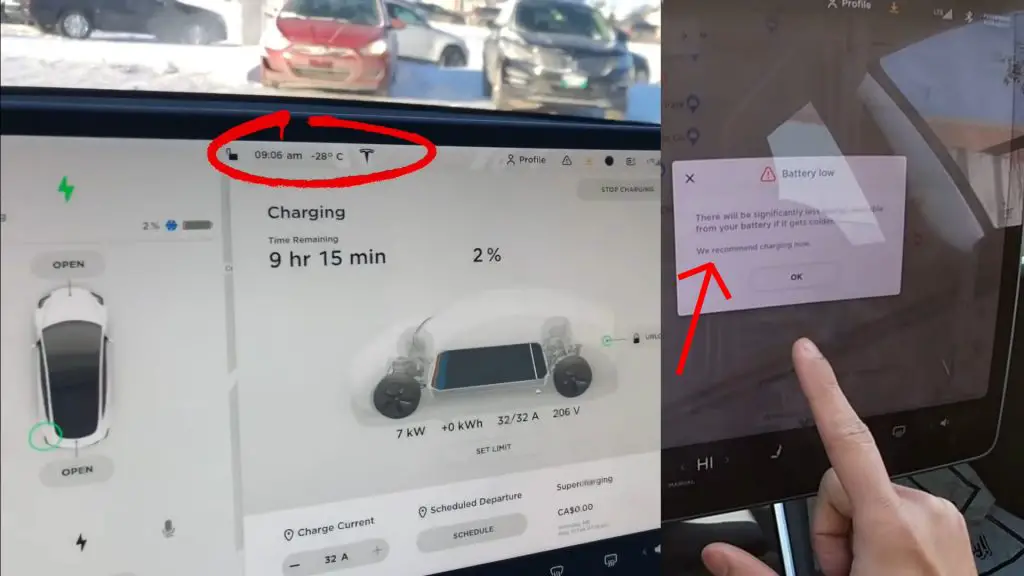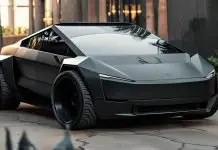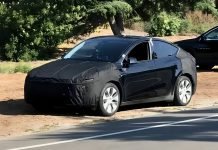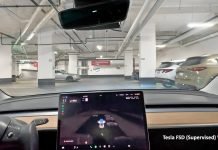A Tesla Model 3 owner in Canada faced an unusual issue when he arrived at a Tesla Supercharger. The owner drove into the Supercharger station with his car at 11% SoC (state-of-charge). The atmospheric temperature at the time was quite low, touching almost -30°C. However, when he plugged his car to the charger, it wasn’t able to charge up.

Tesla Model 3 Fails To Supercharge in -30°C Weather in Canada
According to the driver, the car was showing charging at 0kW. Considering that the car was at 11%, and the cabin heater uses a lot of energy, he had to act quickly. He quickly shifted to a different stall, but it didn’t work. One by one, he kept switching the stalls, but they all showed one of two messages. Either there was a charging error, or it was charging at 0 kW. He tried contacting roadside support, but it was of no use. Finally, with the SoC dropping to 10%, he quickly looked for an A2 level AC charger nearby and found one 6 miles (10 km) away. By the time he reached that charger, the battery had dropped to 2%, which is quite risky. But fortunately for him, the AC charging worked, and he was able to charge his car to a sufficient level to get him home.
What Actually Happened (Why Did The Tesla Supercharger Not Work)
People who have technical knowledge about Li-ion batteries can easily guess what went wrong. But it is important for new EV drivers and future EV owners to understand the basics of cold temperature charging.
The Tesla Supercharger is a 480-volt direct current (DC) fast-charging technology. These fast-charging stations built by the Californian automaker offer different charging rates for the stalls in each station. These charging rates can range from 72 kW, 150 kW or even up to 250 kW. The problem with DC charging, however, is that it doesn’t deliver low power, which may be needed when the battery temperature is very low. And this is exactly what must have happened with the Canadian Model 3 owner.
How Does Temperature Affect Lithium-ion Batteries?, Charging Characteristics of a Li-ion Battery at Low Temperature
The atmospheric temperature and low state-of-charge have less of a role to play in this situation. It is quite clear that the issue encountered by the Tesla owner in question was related to the battery temperature. Li-ion chemistries have certain limitations regarding charging at low temperatures.
The safest option is to keep the temperature of the battery at an optimum temperature for charging. Normally, the battery temperature increases by driving the car because of discharging or the use of the thermal management system. This could very well have happened in this situation as well. While the battery temperature of the Model 3 was quite low at the DC charger, by the time the car reached the AC charger, the battery must have heated up enough for it to work.
But sometimes, just discharging may not be enough to get the battery to an optimum temperature. And so, it is important to pre-condition your battery by the time you reach the Supercharger. Tesla, in particular, has a feature in its Navigation, where it shows the directions to the nearest Supercharger and also heats up your battery by the time you get there.
Many a time, it so happens that the software installed in your electric car prevents you from using energy to heat the battery at a low SoC. Hence, it is important to plan the pre-conditioning in advance to ensure the battery is heated up before charging. It is also important not to let the SoC drop to a very low percentage. Most electric cars advise you to charge up before crossing 20% for this very reason.
AC Charging vs DC Charging
The biggest difference between DC charging and AC charging is whether the conversion of power takes place inside the car or outside. During AC charging, there is a converter inside the car to convert the alternating current to direct current. This can slow down the charging process. But in a DC charger, the AC power from the grid gets converted inside the charger itself before supplying it to the car. Hence, DC charging can be much faster, and it also allows these chargers to be bigger.
But every exciting breakthrough comes with its drawbacks. At low temperatures, an AC charger can heat up the battery while charging because it has low power. A cold battery may not be able to get charged at 72 kW, but the 19.2 kW power of an A2 level AC charger can get the current flowing. Hence, for low-temperature charging (which is not exactly ideal, but sometimes the only option), an AC charger may be the more reliable option.
Our Opinion
When switching to electric vehicles, it is important to understand the various aspects of your battery. It is important to keep the battery at a not-too-low level to prevent such issues. This will also help the battery health, by not letting it into the extreme levels of the battery. And it is very important to understand the characteristics of charging in extreme weather conditions.



















Note that they COULD have designed the DC charger to be able to supply an even lower level of power (10-20 kW), for exactly this situation. Enough to be able to warm the batteries to start charging, and then as the batteries warm from being charged, you can ramp the power up. ICE vehicles are designed to cold-start and refuel after an overnight cold soak at -40C.
Well, SC at least in EUROPE does supply low power without issue. Happened to me few times when driving with a frozen car home from skiing. The screen shows 0 power into the battery but the car starts to heat the battery and as soon as the lowest temperature for charging is reached it starts to charge it. So this issue doesn’t exist in Europe and I don’t see any reason, why SC should not be able to deliver a low power. Makes simply no sense.